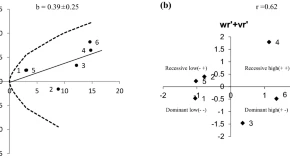Genetic pattern analysis of some quantitative traits in lentil (Lens culinaris Medic.)
Research Articles | Published: 19 July, 2020
First Page: 580
Last Page: 591
Views: 3762
Keywords: Combining ability, Diallel, Dominance, Lens culinaris
Abstract
The 6 × 6 half-diallel crossings among six parental lines for twelve traits were investigated to estimate different genetic parameters and identify superior lentil line combinations. The significant results of the analysis of variance for all the traits except RW proved the parental lines genetically different from each other. Dominance and additivity were studied and over dominance was found in NPBFF, CAMF, NPdPP, NSPP, SWPP and IPW through Wr/Vr and (Wr + Vr′)/Yr′ graphs. The degree of dominance (H1/D)1/2 supported the result of over dominance for all the traits. The asymmetry in the proportion of genes with positive and negative effects in the parents was studied for all the traits and the presence of an excess dominant gene in most of the traits was noted. General combining ability (GCA) for DFF, PHFF, NSBFF, CAMF, NSBMF, NPdPP and NSPP, as well as specific combining ability (SCA) for all the traits except NPBFF and RW were significant indicating the importance of additive and non-additive gene action, respectively. Parents P3, P4 and P5 were assessed as good general combiner from this investigation and the crosses viz. P1 × P2, P1 × P3, P2 × P5, P4 × P5 and P5 × P6 were the best combiners as judged from the specific combining ability effects. So, these parents and crosses need special consideration for the improvement of lentil.

References
- Baker R (1978) Issues in diallel analysis. Crop Sci 18(4):533–536
- Basari R, Samad M, Deb A, Khaleque M (2011) Diallel analysis of soluble protein in root nodules and seeds in blackgram [Vigna mungo (L.) Hepper]. J Biodiv Environ 1:7–15
- Bender DA, Bender AE (2005) A dictionary of food and nutrition. Oxford University Press, New York
- Dickinson A, Jinks J (1956) A generalised analysis of diallel crosses. Genetics 41(1):65
- Gill R, Singh S, Singh J (2010) Studies on combining ability for grain yield and component traits in lentil. J Food Legum 23(34):205–207
- Griffing B (1956) A generalised treatment of the use of diallel crosses in quantitative inheritance. Heredity 10(1):31–50
- Hayman BI (1954) The theory of analysis of diallel crosses. Genetics 39:789–809
- Hayman BI (1958) The theory and analysis of diallel crosses. II. Genetics 43(1):63
- Iqbal A, Khalil IA, Ateeq N, Khan MS (2006) Nutritional quality of important food legumes. Food Chem 97(2):331–335
- Jinks J (1954) The analysis of continuous variation in a diallel cross of Nicotiana rustica varieties. Genetics 39(6):767
- Joshi N, Singh S, Singh I (2005) Variability and association studies in lentil. Indian J Pulses Res 18(2):144
- Karami E (2011) Genetic analysis of some agronomic characters in chickpea (Cicer aretinum L.). Afr J Agric Res 6(6):1349–1358
- Khattak G, Haq M, Ashraf M, McNeilly T (2001) Genetic basis of variation of yield, and yield components in mungbean (Vigna radiata (L.) Wilczek). Hereditas 134(3):211–217
- Kumar S, Srivastava S (2007) Estimation of genetic variances and combining ability in lentil (Lens culinaris). Indian J Agric Sci 77(8):533–536
- Mather K (1949) Biometrical Genetics (1st eds.), Mathuen and Co. Ltd. London
- Patel M, Patel B, Savaliya J, Tikka S (2009) Heterosis and genetic architecture of yield, yield contributing traits and yellow mosaic virus in mungbean [Vigna radiata (L.) Wilczek]. Legume Res Int J 32(4):260–264
- Rathi A, Sindhu J, Katiyar R, Katiyar S (2003) General combining ability studies in lentil. Legume Res 26(2):117–120
- Raymond, J. (2006). World’s healthiest foods: Lentils (India). Health. Retrieved April 14, 2008
- Singh I, Singh J (2003) Combining ability analysis in lentil. Indian J Pulses Res 16(2):95–97
- Zubair M, Ajmal SU, Munir M, Anwar M (2007) Mode of inheritance and genetic variability of some of the traits in mungbean Vigna radiata (L.) Wilczek. Pak J Bot 39(4):1237
Author Information
Department of Genetic Engineering and Biotechnology, University of Rajshahi, Rajshahi, Bangladesh